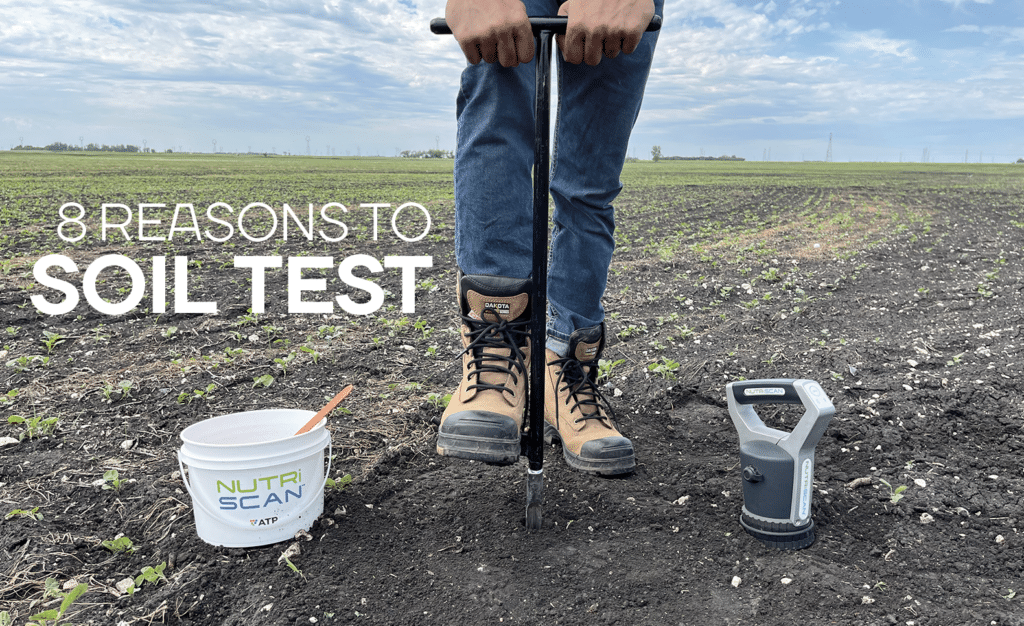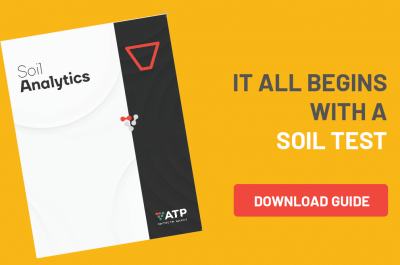
Soil testing is a best management practice (BMP) and a foundational step in preserving a crop’s genetic yield potential. With a robust soil testing program, you can gain a greater understanding of:
1. Economics
- Aids in determining the required nutrients for efficient and economical crop production.
- Helps establish the amount of carry-over nutrients already in the soil.
- Aligns soil nutrient levels with the needs of the plant while factoring in fertilizer prices, allowing the grower to make informed decisions as to how much fertilizer they should apply to achieve their crop’s targeted yield potential.
- The value of a complete soil test and robust nutrient management is displayed in the chart. At the ATP Research Farm, every new product screening study was performed under 2 different nutrient management regimes.
- A standard fertility program the producer did on their field.
- A nutrient management plan based off a complete soil test to achieve maximum yield potential of the growing region.
The average increment yield benefit was 21 bu/ac, 26bu/ac, and 12 bu/ac for canola, wheat and soybean respectively.

2. Proper Plant Nutrition
- Plants require specific quantities of every essential nutrient. Too much or too little of any nutrient can be detrimental. Soil sampling ensures the plant is supplied with balanced nutrition.
3. Soil Nutrient Stewardship
- Regular soil testing tracks fertility history allowing confirmation that soil nutrient mining is not occurring.
- Plants remove a predictable amount of nutrients per amount of biomass grown. If these nutrients are not returned to the soil, via fertilizer application, the overall nutrient status will decline, leading to a potentially less fertile and productive land.
4. Environmental Stewardship
- Prevents over fertilization and potential environmental contamination. When farmers do not soil test, they run the risk of over or under applying fertilizer. When over application occurs, these nutrients are more likely to leach or run-off into waterways and become a source of contamination.
- Geo-referenced soil sampling and variable rate application allow for precise nutrient distribution and placement.
5. Animal and Human Nutrition
- Soil testing helps to attain optimal nutrient density in animal feed as well as into the human food chain.
6. Water Use Efficiency
- Soil testing aids in the identification of soil type to provide a better understanding of a soil’s Water Use Efficiency (WUE).
- Soils are not all uniform. They can vary in color, pH, mineral composition, Organic Matter (OM) and texture.
- The inherent capacity of a field/zone to produce a crop can be limited by the soil’s physical and chemical properties which include OM, pH, Electrical Conductivity (EC), Cation Exchange Capacity (CEC) and texture.
- Texture quantifies the amount of sand, silt, and clay in a soil. Sandy soils allow water to drain more rapidly than soils with smaller particles such as clays.
7. Reduced Pesticide Dependence
- Weeds and pests are opportunists, meaning they grow in areas of low fertility and can compete with the crop.
- By providing suitable fertility, farmers give their crop a competitive edge against weeds.
- Unhealthy plants tend to attract pests and are potentially more susceptible to damage.
- By providing plants with proper nutrition they are better equipped to defend themselves against pests.
8. Soil Health
- Research has shown that beneficial microbes prefer to colonize in the root rhizosphere of plants grown with balanced nutrition.
- Poor nutrition will invite harmful microbes, while proper nutrition will allow beneficial microbes to thrive.
Looking for a quick and easy way to soil test this fall?
NutriScan is a game changing diagnostic technology that gives you access to real-time, rapid, in-field monitoring of soil nutrient status using an easy-to-use, handheld tool – all in a matter of minutes.
For information on NutriScan pricing options or to learn more about the NutriScan, please visit here.

